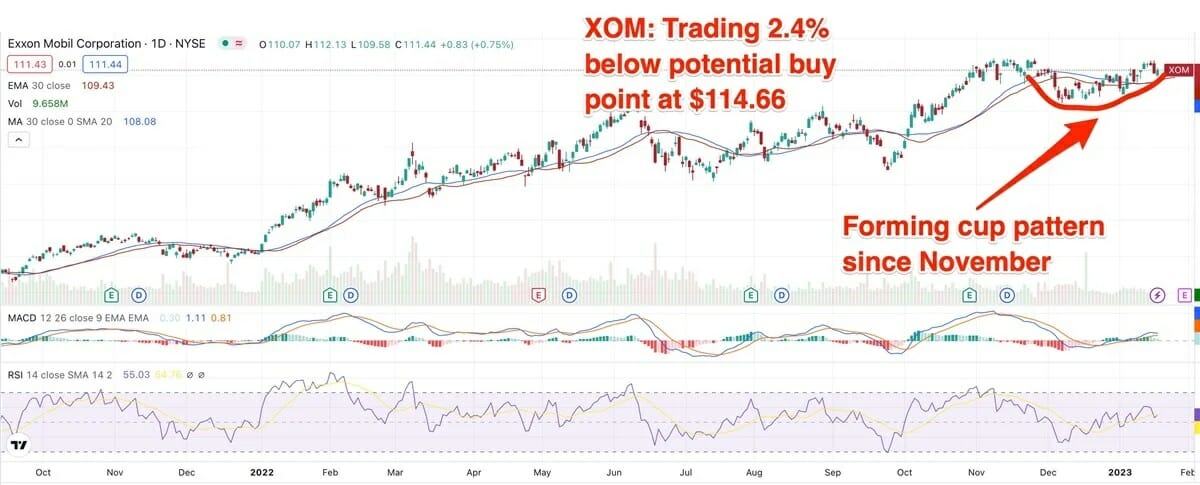- Exxon Mobil shares regained their 50-day moving average on January 10, and are now 2.4% below their November high of $114.66.
- It expects full-year earnings to come in between $21 billion and $24 billion. Wall Street is eyeing earnings of $13.91 per share for 2022, which it reports on January 31.
- The company recently said it intends to double its earnings and free cash flow growth by 2027.
- Analysts expect an increase in the need for oil, due to China’s reopening and high demand for air travel.
- 5 stocks we like better than Exxon Mobil
Exxon Mobil Corporation (NYSE:XOM) is within striking range of clearing a cup-shaped base that the stock began forming in mid-November.
Q4 2022 hedge fund letters, conferences and more
Find A Qualified Financial Advisor
Finding a qualified financial advisor doesn't have to be hard. SmartAsset's free tool matches you with up to 3 fiduciary financial advisors in your area in 5 minutes.
Each advisor has been vetted by SmartAsset and is held to a fiduciary standard to act in your best interests.
If you're ready to be matched with local advisors that can help you achieve your financial goals, get started now.
This, along with its oil-and-gas industry peers, was part of last year’s rally that made energy the only winning sector last year.
Exxon Mobil’s one-year return is 56.21%. As stellar as that was, sector peer Occidental Petroleum Corporation (NYSE:OXY) notched an even better performance, with a one-year gain of 80.24%.
The rally in the entire sector fizzled toward the end of the year. The sector, as tracked by the Energy Select Sector SPDR ETF (NYSEARCA:XLE), began retreating at around the same time as Exxon Mobil. As the largest component within the sector, weighing in at 22.76%, Exxon Mobil has an outsized effect on broad sector direction.
You could say the same about Chevron Corporation (NYSE:CVX), which at 19.62% of sector weighting, also has a say in broad performance.
Exxon Mobil shares regained their 50-day moving average on January 10 and are now 2.4% below their November high of $114.66. At this juncture, $114.66 could represent a potential buy point.
Tied To Commodity Prices, Global Demand
The fortunes of oil-and-gas companies are inextricably linked to factors out of their control, namely commodity prices and global demand. On the former point, oil stocks staged enormous rallies last year on rising prices. In the past six quarters, earnings grew at triple- or even quadruple-digit rates. In the past three quarters, the average earnings growth rate clocked in at 226%, not something you see outside the world of young, glamorous tech stocks.
When it reported third-quarter earnings, Exxon Mobil said it expects full-year earnings to come in between $21 billion and $24 billion. Wall Street is eyeing earnings of $13.91 per share for 2022.
The company is due to report its fourth-quarter and full-year results on January 31, before the opening bell. Analysts expect $3.20 per share on revenue of $105.64 billion. Those would mark increases of 56% and 24%, respectively.
The company recently said it intends to double its earnings and free cash flow growth by 2027.
In December, Exxon Mobil said it would use excess free cash flow to return $50 billion to shareholders through 2024. While returning capital to shareholders, whether through buybacks or dividends, sounds great if you’re an owner, there’s a risk for a capital-intensive industry like energy.
Exxon Mobil and the industry at large enjoyed a cyclical boom; if a recession puts a damper on that, the company may need to increase borrowing to finance new capital projects. That would put a dent in operational efficiencies.
Long History Of Dividend Increases
Like many other well-established mega-caps, Exxon Mobil also uses dividends as a way of rewarding shareholders. Its dividend payments to shareholders increased at an average annual rate of 5.9% over the past 40 years.
MarketBeat dividend data show a yield of 3.25%, and a dividend payout ratio of 29.71%.
Oil prices have been rising this month, pegged to two major developments: The reopening of China’s economy and increased demand for air travel. Some analysts and energy executives predict that higher demand could lead to oil shortages. While that would indeed be a bad development for consumers and industrial users, it would likely be a boon for oil prices and stocks of oil-industry companies.
West Texas Intermediate rose as high as $81.39 intraday Thursday, its highest level in more than two weeks.
Exxon Mobil is investing in more projects to meet future demand. In December, the company said its 2023 investments “are expected to be $23 billion to $25 billion to help increase supply to meet global demand.”
It also said, “More than 70% of capital investments will be deployed in strategic developments in the U.S. Permian Basin, Guyana, Brazil, and LNG projects around the world.”
Should you invest $1,000 in Exxon Mobil right now?
Before you consider Exxon Mobil, you'll want to hear this.
MarketBeat keeps track of Wall Street's top-rated and best performing research analysts and the stocks they recommend to their clients on a daily basis. MarketBeat has identified the five stocks that top analysts are quietly whispering to their clients to buy now before the broader market catches on... and Exxon Mobil wasn't on the list.
While Exxon Mobil currently has a "Moderate Buy" rating among analysts, top-rated analysts believe these five stocks are better buys.
Article by Kate Stalter, MarketBeat







